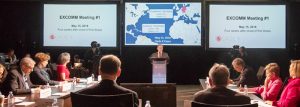 Imagine a terrorist group hellbent on taking Earth’s population back to Stone Age numbers. They manipulate a deadly virus. And release it. Here’s how it could play out.
Imagine a terrorist group hellbent on taking Earth’s population back to Stone Age numbers. They manipulate a deadly virus. And release it. Here’s how it could play out.
The Johns Hopkins Center for Health Security hosted the Clade X pandemic tabletop exercise on May 15, 2018, in Washington, DC. The purpose of the exercise was to illustrate high-level strategic decisions and policies that the United States and the world will need to pursue in order to prevent a pandemic or diminish its consequences should prevention fail. It didn’t end well for the citizens of the world. Here’s their press release:
 The outbreak of a moderately contagious and moderately lethal novel pathogen precipitated a catastrophic end to the scenario in Clade X, the day-long pandemic tabletop exercise hosted by the Johns Hopkins Center for Health Security on May 15 in Washington, DC.
The outbreak of a moderately contagious and moderately lethal novel pathogen precipitated a catastrophic end to the scenario in Clade X, the day-long pandemic tabletop exercise hosted by the Johns Hopkins Center for Health Security on May 15 in Washington, DC.
Clade X simulated a series of National Security Council–convened meetings of 10 US government leaders, played by individuals prominent in the fields of national security or epidemic response. Their dialogue as the scenario unfolded addressed significant uncertainties in current prevention and response capabilities, hamstrung by policy challenges at the federal level.
The scenario opens with the present-day outbreak of a new, serious respiratory disease in Germany and Venezuela. Soon after, Clade X is identified as a novel strain of human parainfluenza virus with genetic elements of Nipah virus. In the weeks that follow a fringe group bent on reducing the human population claims responsibility for the creation and intentional release of the disease. Authorities confirm those claims and verify that the novel strain was indeed engineered by the group’s scientists. There is no vaccine, and pressure grows as pockets of cases appear in the United States. Clade X quickly causes widespread, worldwide anxiety as case counts and deaths mount. Within a year, 150 million people die from the disease—15 million in the United States alone.
At the conclusion of the exercise, the Center presented 6 strategic policy goals needing commitment from the United States to prevent or reduce the worst possible outcomes in future pandemics. Those recommendations are:
- Develop capability to produce new vaccines and drugs for novel pathogens within months not years.
- Pioneer a strong and sustainable global health security system.
- Build a robust, highly capable national public health system that can manage the challenges of pandemic response.
- Develop a national plan to effectively harness all US healthcare assets in a catastrophic pandemic.
- Implement an international strategy for addressing research that increases pandemic risks.
- Ensure the national security community is well prepared to prevent, detect, and respond to infectious disease emergencies.
A full description of each policy recommendation is available on the Clade X website, along with video recordings of the four exercise segments. You can listen here.
The players and their respective roles were:
Player |
Role |
|---|---|
| John Bellinger Fmr. Legal Advisor to US State Department |
Secretary of State |
| Rep. Susan Brooks (R-IN) | Member, House of Representatives |
| Tom Daschle Fmr. Senate Majority Leader |
Senate Majority Leader |
| Julie Gerberding Fmr. Director, Centers for Disease Control and Prevention |
Director, Centers for Disease Control and Prevention |
| Jamie Gorelick Fmr. Deputy Attorney General |
Attorney General |
| Margaret Hamburg Fmr. Commissioner, Food and Drug Administration |
Secretary, Health and Human Services |
| Tara O’Toole Fmr. Undersecretary, Department of Homeland Security |
Secretary, Department of Homeland Security |
| Jeff Smith Fmr. General Counsel, Central Intelligence Agency |
Director, Central Intelligence Agency |
| Jim Talent Fmr. Senator (R-MO) |
Secretary, Department of Defense |
Tom Inglesby, MD, director of the Center, will play the White House national security advisor.
In the weeks ahead, the Center’s Clade X project team will synthesize the most important points from unscripted discussions among players during the exercise and disseminate those findings widely among members of the US and international biosecurity policy communities.
